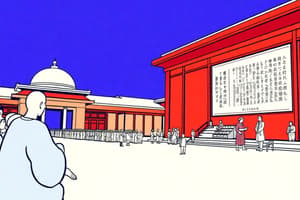Podcast
Questions and Answers
What is the total number of members in the House of Representatives?
What is the total number of members in the House of Representatives?
- 450
- 465 (correct)
- 500
- 400
Which political group has the highest representation in the House of Representatives?
Which political group has the highest representation in the House of Representatives?
- Komeito
- Japan Innovation Party
- The Constitutional Democratic Party of Japan
- Liberal Democratic Party (correct)
What is the minimum age requirement to be a member of the House of Representatives?
What is the minimum age requirement to be a member of the House of Representatives?
- 18 years old
- 21 years old
- 30 years old
- 25 years old (correct)
How many members are elected from single-seat constituencies in the House of Representatives?
How many members are elected from single-seat constituencies in the House of Representatives?
What happens if the Lower House and Upper House make opposing decisions?
What happens if the Lower House and Upper House make opposing decisions?
What is required for a revision of Japan's Constitution?
What is required for a revision of Japan's Constitution?
Which body is identified as the 'sole law-making organ' of Japan?
Which body is identified as the 'sole law-making organ' of Japan?
Which principle is included in the Japanese Constitution that distinguishes it from the Meiji Constitution?
Which principle is included in the Japanese Constitution that distinguishes it from the Meiji Constitution?
Which of the following powers does the National Diet NOT possess?
Which of the following powers does the National Diet NOT possess?
How does the power of the House of Representatives compare to the House of Councilors?
How does the power of the House of Representatives compare to the House of Councilors?
What is the minimum age requirement to be a member of the House of Councillors?
What is the minimum age requirement to be a member of the House of Councillors?
How many total members are there in the House of Councillors?
How many total members are there in the House of Councillors?
Which political group has the highest number of members in the House of Councillors?
Which political group has the highest number of members in the House of Councillors?
What is the term length for members of the House of Councillors?
What is the term length for members of the House of Councillors?
Who appoints the Prime Minister of Japan?
Who appoints the Prime Minister of Japan?
How many ministers are typically part of the Cabinet in Japan?
How many ministers are typically part of the Cabinet in Japan?
What happens if both houses of the Diet cannot reach agreement on designating the Prime Minister?
What happens if both houses of the Diet cannot reach agreement on designating the Prime Minister?
Which of the following statements is true regarding the House of Councillors?
Which of the following statements is true regarding the House of Councillors?
What happens if the House of Representatives passes a non-confidence resolution regarding the Cabinet?
What happens if the House of Representatives passes a non-confidence resolution regarding the Cabinet?
Which of the following is NOT considered a subsidiary organ of the Cabinet in Japan?
Which of the following is NOT considered a subsidiary organ of the Cabinet in Japan?
Which statement accurately describes the Liberal Democratic Party (LDP) in Japan?
Which statement accurately describes the Liberal Democratic Party (LDP) in Japan?
What was the result of LDP losing control of the Lower House in 1993?
What was the result of LDP losing control of the Lower House in 1993?
How have factions within the Liberal Democratic Party (LDP) influenced its leadership?
How have factions within the Liberal Democratic Party (LDP) influenced its leadership?
Which Prime Minister of Japan is associated with major reforms during his tenure from 2001 to 2006?
Which Prime Minister of Japan is associated with major reforms during his tenure from 2001 to 2006?
What characterizes the emerging opposition parties in Japan since the early 1990s?
What characterizes the emerging opposition parties in Japan since the early 1990s?
Who was the head of the government formed by opposition parties from 1993 to 1994?
Who was the head of the government formed by opposition parties from 1993 to 1994?
Which party emerged as the main opposition party in Japan after the dissolution of the New Frontier Party?
Which party emerged as the main opposition party in Japan after the dissolution of the New Frontier Party?
What is the primary role of bureaucrats in Japan's political system?
What is the primary role of bureaucrats in Japan's political system?
Which party is considered the primary opposition party in Japan as of 2017?
Which party is considered the primary opposition party in Japan as of 2017?
What is the primary ideological stance of the Japan Communist Party?
What is the primary ideological stance of the Japan Communist Party?
Which of the following accurately describes Komeito?
Which of the following accurately describes Komeito?
How are Supreme Court judges appointed in Japan?
How are Supreme Court judges appointed in Japan?
What role does the judiciary play concerning the constitutionality of laws in Japan?
What role does the judiciary play concerning the constitutionality of laws in Japan?
Which of the following groups constitutes the 'Iron Triangle' in Japanese politics?
Which of the following groups constitutes the 'Iron Triangle' in Japanese politics?
Flashcards are hidden until you start studying
Study Notes
Japanese Constitution
- Effective from May 3, 1947, with no amendments since.
- Amendments require two-thirds approval from the National Diet and a majority of the public vote.
- Incorporates separation of powers and checks and balances unlike the Meiji Constitution where the emperor held legislative power.
National Diet
- Defined as "the highest organ of state power" and the sole law-making body.
- Responsibilities include:
- Enacting laws
- Approving the budget and national finances
- Ratifying international treaties
- Designating the Prime Minister
- Initiating constitutional amendments.
- Composed of two chambers: House of Representatives (Lower House) and House of Councillors (Upper House).
House of Representatives (Lower House)
- Comprises 465 members with a 4-year term.
- Members must be at least 25 years old; can be dissolved by the Cabinet.
- Election includes 289 from single-seat districts and 176 from proportional representation districts.
- More powerful than the upper house, especially in selecting the Prime Minister, passing budget, and ratifying treaties.
Membership Distribution in Lower House
- Liberal Democratic Party (LDP): 257 members (22 women)
- Constitutional Democratic Party & Independents: 99 members (15 women)
- Japan Innovation Party & Free Education for All: 45 members (5 women)
- Komeito: 32 members (4 women)
- Others, including Japanese Communist Party and independents have smaller representation.
House of Councillors (Upper House)
- Composed of 248 members with a 6-year term; half elected every 3 years.
- Members must be at least 30 years old; not subject to dissolution.
Membership Distribution in Upper House
- LDP: 114 members (23 women)
- Constitutional Democratic Party & Social Democratic Party: 40 members (19 women)
- Komeito: 27 members (4 women)
- Other smaller parties and independents exist.
Prime Minister & Cabinet
- Prime Minister elected from Diet members, requires majority vote.
- Appointed by the Emperor; must be a civilian.
- Responsible for appointing and dismissing ministers and the Cabinet collectively answers to the Diet.
- If a non-confidence resolution is passed by the House of Representatives, the Cabinet must resign unless the House is dissolved.
Political Parties in Japan
- LDP dominates politics with non-ideological, conservative tendencies; power since 1955, except for brief intervals.
- Internal factionalism exists within the LDP with several factions vying for power.
- Major opposition party evolved from the Democratic Party of Japan, split into the Constitutional Democratic Party (CDP).
Other Notable Political Parties
- Japan Social Democratic Party (JSP): Historically the main opposition before the 1990s.
- Japan Communist Party (JCP): Anti-emperor, anti-capitalist stance.
- Komeito: Moderate conservative, junior partner to LDP with Buddhist roots.
- Japanese Innovation Party: Conservative, right-wing populist with hawkish foreign policy.
Bureaucracy
- Plays a critical role in policy-making, drafting, and enforcing legislation.
- Bureaucrats are highly educated and insulated from direct political pressures, reflecting a system where they endure rigorous scrutiny for recruitment.
Judiciary
- Independent judiciary structure comprising Supreme Court, High Courts, District Courts, and Family Courts.
- Supreme Court judges' appointments require Cabinet consensus; has judicial review power, exercised conservatively.
Studying That Suits You
Use AI to generate personalized quizzes and flashcards to suit your learning preferences.




